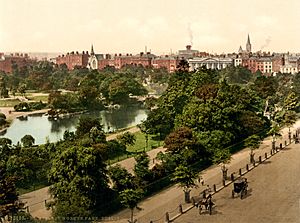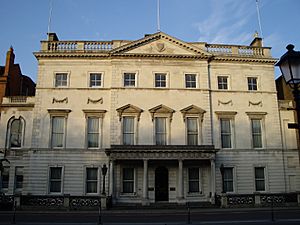St Stephen's Green facts for kids
Quick facts for kids St Stephen's Green |
|
|---|---|
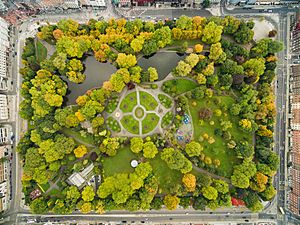
Aerial view of St Stephen’s Green
|
|
| Lua error in Module:Location_map at line 420: attempt to index field 'wikibase' (a nil value). | |
| Type | City park |
| Location | Dublin, Ireland |
| Area | 8.9 ha (22 acres) |
| Created | 1664 |
| Operated by | Office of Public Works |
| Status | Open all year |
| Public transit access | St Stephen's Green station |
| Website | ststephensgreenpark.ie |
St Stephen's Green (Irish: Faiche Stiabhna) is a beautiful garden square and public park right in the heart of Dublin, Ireland. It's often just called Stephen's Green. The park you see today was designed by William Sheppard and opened to everyone on July 27, 1880, thanks to Lord Ardilaun.
This park is super close to Grafton Street, one of Dublin's main shopping areas, and a shopping centre named after it. Many important offices are also around the park, and there's a stop for Dublin's Luas tram line. At about 8.9 hectares (22 acres), it's the biggest park among Dublin's old Georgian squares, like nearby Merrion Square.
The park is shaped like a rectangle. It's surrounded by streets that used to be very busy. But since 2004, traffic has been reduced, making it a nicer place to visit. These four streets are called St Stephen's Green North, South, East, and West.
Contents
History of St Stephen's Green
The name St Stephen comes from an old hospital for people with a skin disease called leprosy, which was dedicated to Saint Stephen. Before 1663, St Stephen's Green was a wet, marshy area of about 60 acres on the edge of Dublin. People used it for grazing animals.
In 1663, the Dublin Corporation (the city's government) saw a chance to make money. They decided to fence off the middle of the common land and sell plots of land around the edges for building houses. The area was measured, and the land was divided into 96 plots, with a 27-acre green in the middle. A wall was built around the park in 1664.
At first, simple two-story houses were built. By the late 1700s, many of these were replaced by grander Georgian-style buildings. The Green became a popular spot for the city's wealthier residents. Today, most of the buildings around the square are townhouses from the 18th and 19th centuries.
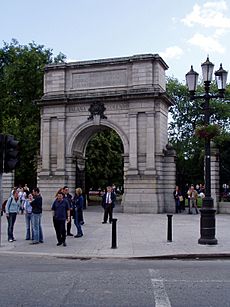
In 1814, a group of local householders took control of the Green. They changed its design and replaced the walls with railings.
After Prince Albert (Queen Victoria's husband) died, Queen Victoria suggested renaming St Stephen's Green to Albert Green and putting a statue of him there. But the people of Dublin and the city government strongly disagreed, which made the Queen quite upset!
For a long time, only people living nearby could go into the Green. But in 1877, a law was passed to open it to everyone. This happened because of Sir A.E. Guinness, a member of the famous Guinness family who brewed beer. He paid for the park to be redesigned into its current form in 1880 and then gave it to the city for everyone to enjoy. To thank him, the city put up a statue of him, which you can see facing the College of Surgeons.
During the Easter Rising in 1916, a group of Irish rebels, led by Michael Mallin and Constance Markievicz, took over St Stephen's Green. They were about 200 to 250 people. They used cars to block the streets around the park and dug trenches inside the park for defense. This was different from other groups who took over buildings. It turned out to be a tricky plan because the British Army took positions in the Shelbourne Hotel, which overlooked the park. From there, they could shoot down into the trenches. The rebels then moved to the Royal College of Surgeons nearby.
There's a famous story from the Rising: during the fighting, the gunfire stopped for a short time so the park's groundsman could feed the ducks!
Today, the Office of Public Works (OPW) manages the park for the Irish government.
Exploring St Stephen's Green Park
How the Park Changed Over Time
The park's look has changed a lot over the years. The first big change was in 1670 when two rows of lime trees were planted around the edges. This was its first fence. The wet ground was drained with a ditch. Back then, only rich people who owned land around the park could go inside.
In 1815, the park was redesigned by Arthur Neville, the city's surveyor. He added winding paths and iron fences. But it was still closed to the public.
In the 1860s, people started campaigning to open the park to everyone. The city engineer, George W. Hemans, suggested new designs to make it easy to walk around. This included adding four gates at each corner, connected by paths. Many of his ideas, like the gates and connecting paths, were used in the final design by William Sheppard and A.L. Cousins, who were supported by Lord Ardilaun. Lord Ardilaun also helped bring in many unique trees and plants for the park.
What You'll Find in the Park Today
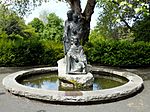

St Stephen's Green is one of Dublin's oldest public lands, but its current design comes mostly from the 1800s. The park is roughly rectangular, about 550 by 450 meters, with a formal garden in the middle.
By 1758, the tree-lined paths around the park had names: Beaux Walk (north), Leeson's Walk (south), Monck's Walk (east), and French Walk (west).

One special part of the park is in the northwest corner: a garden for the blind. It has plants with strong scents that you can touch, and their names are written in Braille.
Further north, there's a large lake where you can see ducks and other water birds. The lake has a man-made waterfall and a bridge called O'Connell Bridge. It's fed by water from the Grand Canal.
On the south side of the main garden, there's an open grassy area with a bandstand. This is a popular spot for students, workers, and shoppers to relax on sunny days.
There's also a playground with separate areas for younger and older kids, which was updated in 2010.
The park used to have a statue of King George II on horseback, put up in 1758. But it was blown up in 1937 by Irish Republicans.
Other interesting things to see include:
- The Fusiliers' Arch at the Grafton Street corner. It remembers soldiers from the Royal Dublin Fusiliers who died in the Second Boer War.
- A fountain showing the Three Fates near the Leeson Street gate. This statue was a gift from the German people in 1956, thanking Ireland for helping refugee children after World War II.
- A seated statue of Lord Ardilaun on the west side. He's the person who gave the Green to the city.
- The Yeats memorial garden with a sculpture by Henry Moore.
- A bust of James Joyce facing his old university building.
- A memorial to the Fenian leader Jeremiah O'Donovan Rossa near the Grafton Street entrance.
- A bronze statue of Theobald Wolfe Tone at the Merrion Row corner. He was a leader of the 1798 rebellion.
- A memorial to the Great Famine (1845–1850) by Edward Delaney.
- A bust of Constance Markievicz on the south side of the central garden.
- A statue of Robert Emmet across from where he was born.
- A memorial bust of Thomas Kettle, who died in World War I.
Buildings Around St Stephen's Green
Some of the oldest houses still stand on the south and north sides of the Green. You can spot them by their lower height and narrower fronts. Later buildings on the east side are much bigger and grander.
Iveagh House on the south side was made by joining two older houses in the 1860s. The Guinness family gave it to the Irish government in 1939. Now, it's the main office for the Department of Foreign Affairs.
Also on the south side are Newman House and University Church. These buildings were part of the Catholic University of Ireland, founded in the 1800s.
The Unitarian Church, built in the Gothic revival style, is on the west side of St Stephen's Green.
The Royal College of Surgeons in Ireland (number 123) is also on the west side. It's home to the oldest medical school in the Republic of Ireland.
At the top of Grafton Street, on the west side, is the Stephen's Green Shopping Centre, built in 1988. It was Ireland's largest shopping centre at the time. Its design looks like a big greenhouse facing the Green.
On the north side of St Stephen's Green, there were four houses that are now two clubs: the Stephen's Green Hibernian Club and the Kildare Street and University Club. This side also has the historic Shelbourne Hotel, Dublin's only Victorian hotel still standing. You can also find The Little Museum of Dublin here, which is in a restored Georgian house.
Heritage House at 23 St Stephen's Green was once a tearoom. It hosted the first public Alcoholics Anonymous meeting in Ireland in 1946.
Loreto College, St Stephen's Green, a well-known girls' school, is at number 53 on the east side.
St Vincent's Hospital used to be in buildings on the east side of St Stephen's Green before moving to a suburb.
In the mid-1900s, some of the old Georgian buildings on the Green were pulled down to make way for modern office blocks. Most of the east side now has newer buildings that look like the old ones.
Getting to St Stephen's Green
Many Dublin Bus routes, including 7b, 7d, 11, 32x, 37, 41x, 44, 46a, 61, 84x, 145, 155, and 757, have stops along the east side of the square.
The Green line of the Luas tram system stops at the St Stephen's Green stop on the western side of the park. These trams continue to Broombridge station in Cabra.
See also
 In Spanish: St Stephen's Green para niños
In Spanish: St Stephen's Green para niños


